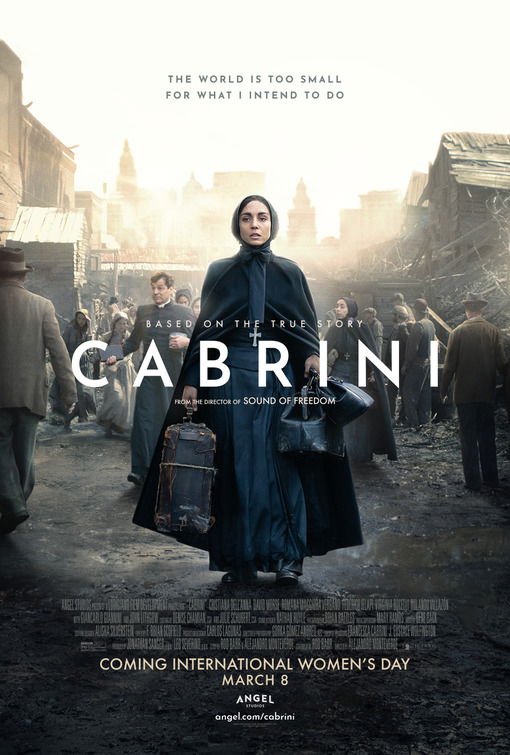“Faith Overcomes Poverty”
What You Need To Know:
CABRINI is a powerful story about Mother Cabrini’s love for the afflicted in America, especially her fellow Italian immigrants. The movie has a strong Christian, moral worldview. It stresses that faith overcomes fear, and that love is stronger than violence. It’s also steeped in Catholic imagery, but features prayer and the reciting of God’s Word. The astounding cinematography, compelling performances, and well-paced story result in an inspiring portrayal of the real-life saint. Due to some violence and adult themes and scenes, MOVIEGUIDE® advises caution for younger viewers.
Content:
Very strong Christian, moral, biblical worldview from a Roman Catholic perspective, the importance of the Gospel is emphasized, Cabrini’s main goal is to show Christ’s love to the poor and vulnerable, and there is plenty of Catholic imagery and elements, such as churches, crosses, prayer, and Scripture;
One SOB obscenity, plus there are some racist names for immigrants from Italy, Ireland and Poland, as well as Jewish immigrants ;
The environment of Five Points is dirty and perilous for children, orphans live in sewer systems, one immigrant girl is forced to work as a prostitute, and her employer beats her frequently, a man is stabbed with a knife and killed, a young boy shoots a man in the leg, both implied and explicit examples of children’s parents dying due to illness, a scene of arson, a boy dies in a coal factory accident, a scene shows many men were injured in factory explosion, brief pans across gruesome injuries, and the violence is intense, but not gory, though it feels true to the times;
No sex, although several scenes imply prostitution, in one scene a government official recognizes one of Cabrini’s orphans who was previously a prostitute;
No nudity; Alcohol Use/Abuse: There is alcohol throughout, plus a few scenes take place in a bar where men are clearly drunk;
Characters smoke throughout, as was the norm for the time; and,
Some stereotyping and name calling, some authorities in the Catholic Church are very negative in their opposition to Mother Cabrini, and some New Yorkers are very Anti-Italian.
More Detail:
The movie begins as Mother Cabrini works with other nuns in Lombardy, Italy. However, Cabrini feels called by God to expand her mission to the poor and vulnerable in the world. Despite several letters to the Pope in Rome, her desire to begin a mission in China is denied multiple times.
Mother Cabrini is persistent, however, and eventually receives a letter asking her to travel to Rome. While Cabrini believes she’s being summoned because they have rethought her proposal, she discovers they only wanted to deny her in person.
However, Cabrini isn’t content with a no from anyone but the Pope himself. She demands a meeting. Pope Leo XIII appreciates her candor and agrees to let her go on a mission outside of her home country of Italy. Instead of China, Pope Leo XIII recruits Cabrini to go to New York City and help aid the impoverished immigrants who live in slums.
Cabrini agrees to the task. So, in 1889, she and six members of the Missionary Sisters of the Sacred Heart of Jesus boat to Five Points, New York. As soon as they arrive, Cabrini and the other six nuns experience the harsh realities that New York City presents to Italian immigrants. However, Mother Cabrini is undeterred by the violence and seemingly hopeless circumstances. She and her small group of nuns get to work on plans for a new orphanage.
In the process, Cabrini relies on prayer and her steadfast faith in God to transform the lives of Italian immigrants and change the hearts of the ruling authorities in both America and Italy.
CABRINI leans into the historical fact that Mother Cabrini is a woman, and that she must work in a Catholic Church and a world that’s dominated by men. While some of the language used is reminiscent of politically correct language used today, within the context of the true story these lines serve Cabrini’s story rather than a political agenda. It is also used to contrast, in a compelling way, Cabrini’s heart for the lowly and the lack of sympathy she receives from those in power.
Cabrini would later become the patron saint of immigrants, and the first U.S. citizen to be canonized. Cabrini is passionate about her Gospel call to serve children and the poor but is faced with obstacles and adversity every step of the way. Despite sexism, racism and even a terminal illness, Cabrini shows unwavering faith in God and her mission.
CABRINI is very well directed, and the screenwriter included great jeopardy and orchestrated the storyline very well. That said, there are a few didactic moments, some stereotyping and frequent name calling. Also, some authorities in the Catholic Church are very negative in their opposition to Mother Cabrini and some New Yorkers are very anti-Italian, but Mother Cabrini deals with them by opening their eyes to the truth.
CABRINI is a powerful story about Mother Cabrini’s love for the afflicted in America, especially her fellow Italian immigrants. The movie has a strong Christian, moral worldview, in a Roman Catholic context. It stresses that faith overcomes fear, and that love is stronger than violence. It also is steeped in Catholic imagery, features prayer, and the reciting of God’s word. The astounding cinematography, compelling performances, and well-paced story result in an inspiring portrayal of the real-life saint. Due to some violence and adult themes, MOVIEGUIDE® advises caution for older children.


 - Content:
- Content: 

